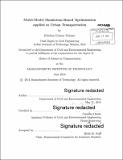| dc.contributor.advisor | Carolina Osorio. | en_US |
| dc.contributor.author | Selvam, Krishna Kumar | en_US |
| dc.contributor.other | Massachusetts Institute of Technology. Department of Civil and Environmental Engineering. | en_US |
| dc.date.accessioned | 2014-09-19T21:43:11Z | |
| dc.date.available | 2014-09-19T21:43:11Z | |
| dc.date.copyright | 2014 | en_US |
| dc.date.issued | 2014 | en_US |
| dc.identifier.uri | http://hdl.handle.net/1721.1/90158 | |
| dc.description | Thesis: S.M. in Transportation, Massachusetts Institute of Technology, Department of Civil and Environmental Engineering, 2014. | en_US |
| dc.description | Cataloged from PDF version of thesis. | en_US |
| dc.description | Includes bibliographical references (pages 63-65). | en_US |
| dc.description.abstract | Transportation agencies often resort to the use of traffic simulation models to evaluate the impacts of changes in network design or network operations. They often have multiple traffic simulation tools that cover the network area where changes are to be made. Nonetheless, these multiple simulators may differ in their modeling assumptions (e.g., macroscopic versus microscopic), in their reliability (e.g., quality of their calibration) as well as in their modeling scale (e.g., city-scale model versus regional-scale model). The choice of which simulation model to rely on, let alone of how to combine their use, is intricate. A larger-scale model may, for instance, capture more accurately the local-global interactions; yet may do so at a greater computational cost. This thesis proposes a methodology that enables the simultaneous use of multiple traffic simulation models. We propose a simulation-based optimization algorithm that embeds information from simulation models with different levels of accuracy and with different levels of computational efficiency. The algorithm combines the use of high-accuracy low-efficiency models with low-accuracy high-efficiency models. This combination leads to an algorithm that can identify points (e.g., network designs, traffic management strategies) with good performance at a reduced computational cost. We evaluate the performance of the algorithm with a traffic signal control problem on a small network, as well a large-scale city network. We show that the proposed algorithm identifies signal plans with excellent performance, i.e., with reduced average trip travel times, while doing so with a reduction in the computational cost. | en_US |
| dc.description.statementofresponsibility | by Krishna Kumar Selvam. | en_US |
| dc.format.extent | 65 pages | en_US |
| dc.language.iso | eng | en_US |
| dc.publisher | Massachusetts Institute of Technology | en_US |
| dc.rights | M.I.T. theses are protected by copyright. They may be viewed from this source for any purpose, but reproduction or distribution in any format is prohibited without written permission. See provided URL for inquiries about permission. | en_US |
| dc.rights.uri | http://dspace.mit.edu/handle/1721.1/7582 | en_US |
| dc.subject | Civil and Environmental Engineering. | en_US |
| dc.title | Multi-model simulation-based optimization applied to urban transportation | en_US |
| dc.type | Thesis | en_US |
| dc.description.degree | S.M. in Transportation | en_US |
| dc.contributor.department | Massachusetts Institute of Technology. Department of Civil and Environmental Engineering | |
| dc.identifier.oclc | 890198384 | en_US |
